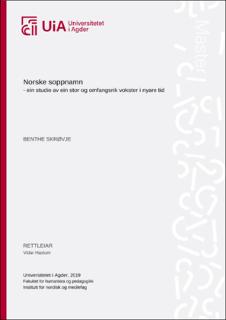| dc.description.abstract | Thisthesisis a study of Norwegian fungi names. We find funginames on three different levels, common namesfor fungi,Norwegian professional namesfor fungi and scientific fungal names. The professional Norwegian mushroom names are the focus in the study. The names investigated arefrom the publication Norske soppnavn(Norges sopp-og nyttevekstforbund, 2011).The thesis addresses origin, language structure, content and use of funginames.Norwegian culture has traditionally been skeptical of fungi, and they have not been important as eitherfood, ritual stimuli or other uses, so there are very few inherited words and popular Norwegian mushroom names. As science has evolved, yet moreNorwegian professional funginames have evolved. In the early 1800-hundreds there were less than 30 names, in 2011 the number has grown to about 3000. The vast majority of these are literal constructionsthat have come from the academic area. The funginames are createdin a linguistic and scientific tradition. Theimmensegrowth in professional Norwegian funginames primarily emergedfrom the end of the 19th century until today.Some common funginames, some loans from a common European language heritage,and strong influenceby Swedish funginames are the mainstay of the current fungilexicon. Funginamesusually consist of a primary nameas basis, and as one finds new species, one has developed and rebuilt the funginames. The funguslexicon is constantly evolving and the academiccommunity has great authority. We use funginames to identify species, and the semantic content of fungi names meetsthis need to say something concrete about how the funguslooks, when it grows, how it smells and so forth. In the funginames,you will find many descriptive adjectives and metaphors. The fungilexicon is lively and extensive, and a result of a deliberate linguistic and academicworkwith fungi.Knowledge aboutfungispecies materializes in theNorwegian funginames. Species diversity is at risk,the environmental issue is the most important issue, Norwegian funginames are thereforeamost relevant study. | en_US |

